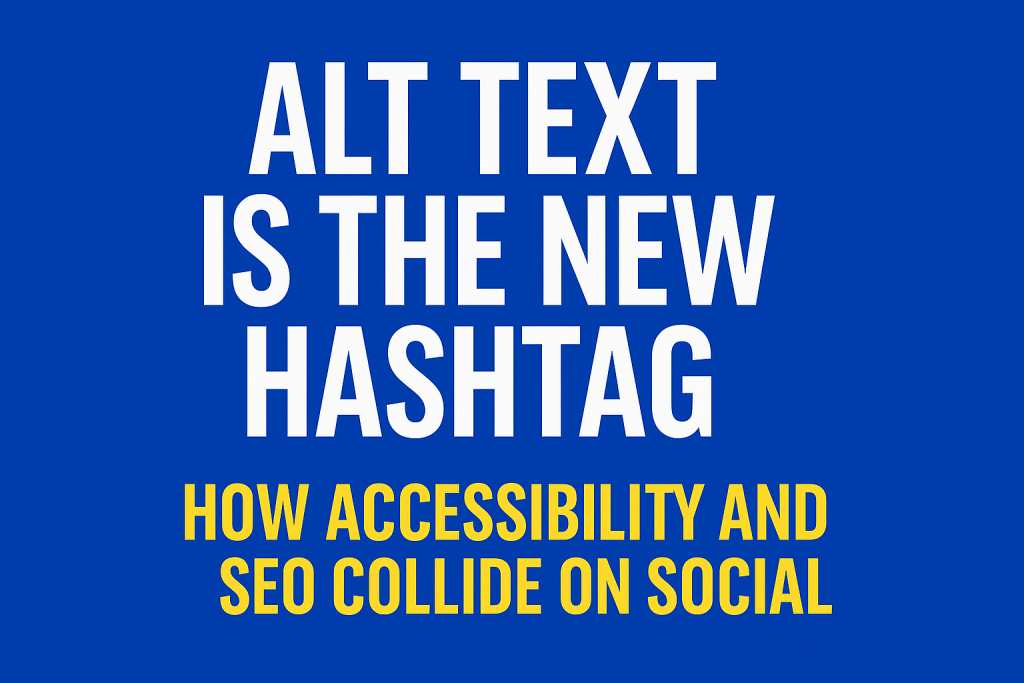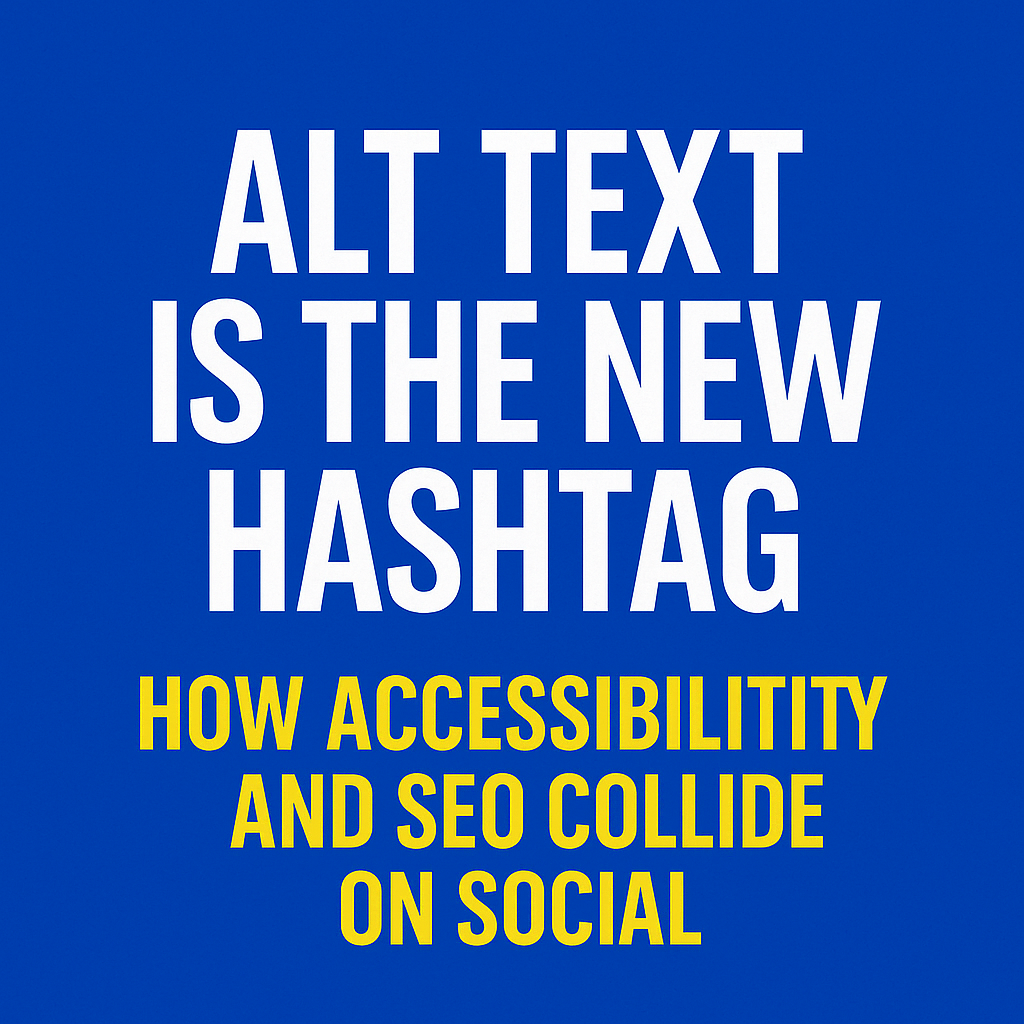But while everyone is chasing the loudest trends, one of the quietest features in digital marketing has become a breakout star—alt text.
Historically known as an accessibility tool for screen readers, alt text is quickly becoming a powerhouse for SEO, social media discoverability, algorithm training, content relevance, and—yes—better brand perception.
Alt text is no longer optional.
It’s no longer “just for accessibility folks.”
It’s no longer something marketers can ignore.
Alt text is the new hashtag.
And the brands who understand this shift early will win the next era of social media visibility.
What Exactly Is Alt Text—and Why Is It Blowing Up?
Alt text, short for “alternative text,” is a written description of an image that:
-
Helps screen readers describe visuals to visually impaired users
-
Helps search engines understand image content
-
Helps social media platforms categorize and index images
-
Helps AI models (including algorithmic ranking systems) identify themes, objects, and context
Originally built as an accessibility tool under WCAG guidelines, alt text is entering mainstream marketing awareness because:
-
Social platforms now use AI to read your images.
-
Alt text directly reinforces what the AI thinks it sees.
-
Creators are using alt text the same way they use hashtags—to add context.
-
Search engines now surface alt-text-optimized content higher in results.
Brands who fail to use alt text now lose discoverability, relevance, and algorithmic clarity—three pillars of modern marketing.
Why Alt Text Is Becoming a Social Media Ranking Signal
For years, hashtags have been the go-to for categorization. You could slap on #MarketingTips or #WebDesign and instantly signal to the algorithm what your post was about.
But social platforms are moving away from hashtags:
-
Instagram deprioritizes hashtags in favor of search-based discovery.
-
TikTok uses semantic understanding more than keyword scanning.
-
X (Twitter) shows fewer hashtag search results.
-
LinkedIn pushes content based on relevance and user intent—not keyword load.
In this shift toward semantic discovery, alt text fills the gap that hashtags used to dominate.
Here’s how:
1. Alt text trains platform AI
The algorithm sees your image.
But does it understand your image?
Alt text gives platforms explicit instructions:
“This image is about AI-powered marketing strategy.”
“This visual shows a CEO speaking at a digital leadership conference.”
“This graphic demonstrates a five-step content strategy framework.”
Suddenly your content becomes easier to categorize, easier to recommend, and easier to boost.
2. Alt text influences search-based discovery
Instagram and TikTok now act like visual search engines.
People search:
-
“AI marketing”
-
“web design inspo”
-
“brand strategy tips”
-
“SEO how-to”
Alt text acts like the caption behind the image—except it’s prioritized by machine learning.
3. Alt text improves context beyond hashtags
Hashtags tell platforms what category you want to be found in.
Alt text tells platforms exactly what your content is about.
Hashtags: broad categories
Alt text: precise intent
4. Alt text enhances long-tail SEO
If you’re posting educational content, carousels, infographics, or visual tutorials, your alt text can do the SEO heavy lifting:
-
More clicks from image search
-
Higher blog visibility
-
Stronger topical authority
-
Higher organic discoverability on social
5. Alt text signals inclusiveness—and users reward it
Over 2.2 billion people live with some form of visual impairment.
Brands who write strong alt text show:
All of which elevate brand reputation, especially among Millennials and Gen Z.
The New Content Formula: Caption + Hashtags + Alt Text
Social media posts now require three layers of context to maximize performance:
1. Captions
Explain the story. Build emotion. Create connection.
2. Hashtags
Add general categorization (less important than before, still useful).
3. Alt Text
Add precise meaning and strengthen SEO.
Alt text is the hidden metadata that ties everything together.
Why Alt Text Is Exploding in 2025: Major Platform Shifts
Across all major platforms, the move toward visual-first AI means alt text is more important than ever.
Instagram
IG’s “visual search” feature allows users to search by concept—not hashtags. Alt text directly feeds that database.
Facebook
Meta’s AI auto-generates alt text for images (often inaccurately).
Custom alt text overrides AI’s guesswork.
TikTok
Visual recognition and search-first functionality rely heavily on context-building metadata, including alt text.
LinkedIn
LinkedIn has quietly improved its image parsing tools. Posts with descriptive alt text perform better in search-based discovery.
X (Twitter)
X is prioritizing accessibility compliance—and posts with alt text are more likely to get visibility and engagement.
Pinterest
Pinterest is literally a visual search engine.
Alt text = SEO rocket fuel.
The SEO Power Behind Alt Text: Why Google Loves It
While social algorithms leverage alt text for categorization, search engines take it further.
1. Google uses alt text to understand subject matter
Without alt text, Google guesses what’s in your image.
With alt text, Google KNOWS.
2. Alt text boosts keyword relevance
When used strategically—and not spammy—alt text acts as another layer of keyword visibility.
3. Image search is exploding
Google image search accounts for 22% of all web searches.
If your images aren’t optimized, you’re missing a massive traffic channel.
4. Alt text supports E-E-A-T
Expertise
Experience
Authority
Trust
Images with relevant alt text reinforce the topical authority Google wants to see in ranking sources.
How to Write Alt Text That Actually Boosts SEO and Social Reach
There is a right way—and a wrong way—to write alt text.
Bad Alt Text Looks Like This:
“Man.”
“Marketing graphic.”
“Business photo.”
“Image of a laptop.”
Useless. Generic. Zero SEO value.
Great Alt Text Looks Like This:
“A digital marketer analyzing AI-driven analytics dashboard showing real-time performance metrics.”
“A carousel graphic showing ‘5 Steps to Improve Web Conversion Rates’ in bold typography.”
“A female entrepreneur presenting a growth strategy to a team in a modern office environment.”
This describes:
✔ what’s happening
✔ context
✔ intent
✔ purpose
✔ meaning
Google and social algorithms love that.
Alt Text Best Practices for 2025 and Beyond
1. Be descriptive, but concise
Aim for 10–125 characters. Anything longer becomes a caption.
2. Include keywords naturally
Don’t force it.
Don’t keyword-stuff.
Don’t add irrelevant hashtags.
3. Describe the content, not the platform
Bad: “Image for Instagram post”
Good: “A minimalist graphic highlighting AI’s impact on digital marketing.”
4. Include context that isn’t visually obvious
For example:
“The graphic promotes a free webinar on predictive design for websites.”
5. Avoid phrases like “image of” or “picture of”
Screen readers already know it’s an image.
6. Match your alt text to search intent
If someone searched Google for “AI marketing strategies,” would your image match?
7. Write alt text as if you’re explaining the image to a human
Because you are.
Alt Text Is Now a Competitive Advantage
The truth is simple:
Most brands still aren’t using alt text.
Of the ones who do, many write terrible descriptions.
Even fewer use alt text strategically for SEO and discoverability.
This creates an enormous competitive gap for early adopters who:
-
Write descriptive alt text
-
Add keyword-rich context
-
Post image-based content consistently
-
Use alt text as a micro-SEO tool
-
Train algorithms with precision
When everyone else is late to the game, you’ll already own the rankings.
Why Alt Text Plays a Role in Brand Identity and UX
Alt text isn’t just technical.
It’s emotional, human-centered, and brand-building.
1. Accessibility = trust
A brand that makes content accessible communicates care, compassion, and professionalism.
2. Clarity = user experience
Clear alt text reduces confusion and elevates clarity—core UX principles.
3. Authenticity = loyalty
Communicating with intention is a sign of brand maturity and integrity.
4. Inclusivity = modern branding
Consumers increasingly expect brands to be inclusive—not just compliant.
Using Alt Text Strategically on Each Platform
Instagram
Best for: SEO discovery, topic classification
Recommended: 10–15 words
Tip: Describe carousels slide by slide.
LinkedIn
Best for: Professional context building
Recommended: Contextual, descriptive
Tip: Focus on industry relevance.
Facebook
Best for: AI override
Recommended: Clear, simple descriptions
Tip: Avoid marketing jargon.
TikTok
Best for: Search-first indexing
Recommended: Concept description
Tip: Include what the viewer will learn from the visual.
Pinterest
Best for: keyword ranking
Recommended: Keyword-rich, long-tail SEO
Tip: Treat alt text like a micro blog.
X (Twitter)
Best for: accessibility-first posting
Recommended: Simple, clear, concise
Tip: Describe emotion or intent.
Alt Text Mistakes That Hurt Your SEO and Accessibility
Avoid these pitfalls:
❌ Writing alt text for the algorithm only
Human-first always wins.
❌ Keyword stuffing
Google penalizes unnatural patterns.
❌ Using alt text as a caption dump
Captions belong in… the caption.
❌ Leaving alt text blank
Missing opportunity. Missing context.
❌ Using auto-generated alt text
Meta’s AI often misidentifies images.
❌ Describing irrelevant details
Don’t overload with unnecessary specifics.
How to Build a Repeatable Alt Text Workflow for Your Brand
Here’s a simple process teams can follow:
Step 1: Identify the purpose of the image
Is it educational? Inspirational? Promotional?
Step 2: Identify the key visual elements
Who is in the image? What’s happening? What stands out?
Step 3: Identify the SEO or social keyword
Choose ONE.
Not five.
Step 4: Craft a 10–20 word alt text description
Natural language only.
Step 5: Review for accessibility
Would this make sense to a blind user?
Step 6: Publish consistently
Every image, every carousel, every infographic.
Real Examples: Alt Text That Performs vs. Alt Text That Fails
❌ Weak Alt Text:
“Marketing post.”
✔ Strong Alt Text:
“A branded infographic outlining the 2025 digital marketing funnel from awareness to conversion.”
❌ Weak Alt Text:
“Woman working.”
✔ Strong Alt Text:
“A designer using a dual-monitor setup to build a user interface for a SaaS dashboard.”
❌ Weak Alt Text:
“Business team meeting.”
✔ Strong Alt Text:
“A leadership team reviewing AI-enhanced customer insights during a strategy workshop in a modern office.”
The Future of Social SEO Depends on Alt Text
Here’s the truth:
Algorithms are becoming visually intelligent.
Search is becoming visual-first.
Users expect inclusive content.
Brands need metadata to stay relevant.
Discoverability is now multimodal—not just keyword-based.
Alt text is no longer an afterthought.
It’s infrastructure.
It’s visibility.
It’s discoverability.
It’s accessibility.
It’s SEO.
And in an age where content is infinite and attention is scarce, every pixel—and every word describing those pixels—matters.
If hashtags were the king of categorization from 2012 to 2022, then alt text is the new ruler of 2025 and beyond.
Early adopters will dominate.
Late adopters will disappear.
So optimize now—before your competitors figure it out.










